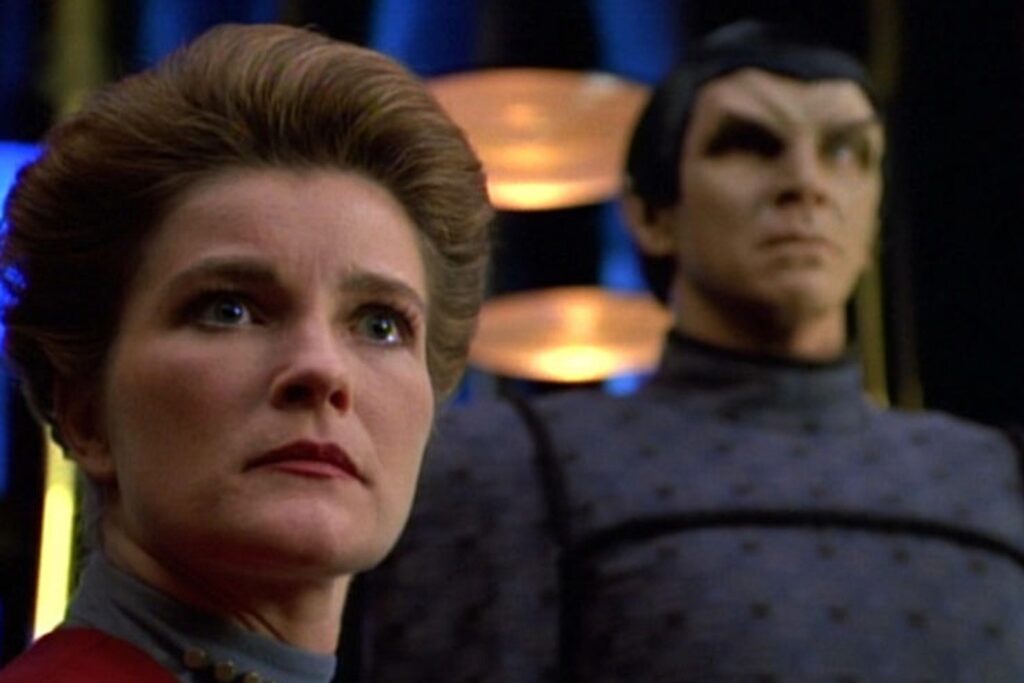Star Trek: Voyager‘s premise was both its greatest boon and its biggest curse. Flinging the titular Starfleet vessel tens of thousands of lightyears away from Federation space into unchartered territory wasn’t just a fantastic evolution of the franchise’s original intent to boldly go where no man had gone before, but a vector for fascinating story ideas about resource management, ethics, first contact, and a million other Star Trek ideas that could be re-imagined in a context where the world established in The Next Generation and Deep Space Nine was completely inaccessible to our heroes.
But it also meant that whenever Voyager would inevitably float a plotline about a shortcut that would get the crew back home ahead of schedule, the audience knew immediately: it was doomed to fail. Voyager wasn’t going to suddenly come to an end in a random episode in the middle of a season, let alone just six episodes in, as was seemingly the case 30 years ago today with the premiere of “Eye of the Needle.” Whether the story demanded the potential of a way to shave off huge chunks of Voyager‘s estimated 70-year journey back to the Alpha Quadrant, or skip over it entirely, there was always something of a fallacy involved—either the crew would have to fail in getting that shortcut, or they’d have to get in in such a way that its impact on their voyage home would be immaterial, and therefore inconsequential to the audience.
Which is why then it’s so bold that “Eye of the Needle” takes this idea head on so early into Voyager‘s run. But it’s even bolder for being perhaps one of the show’s best examples of how exactly to handle this fallacy that it would ever do before Voyager was eventually allowed to come home in its final episodes.

The titular eye of the episode is a wormhole that Harry Kim discovers with the potential to lead back to the Alpha Quadrant in some form. From the get go, the episode plays with this rise and fall of hope and reality. We see our heroes get their hopes up that this discovery could provide any kind of link back home, a total return or otherwise, only for them to be dashed by a revelation or complication—first, it’s that the wormhole is microscopic, then, it’s that a ship on the other side of it is in fact a Romulan science vessel on a covert mission hesitant to trust a Starfleet crew claiming a seeming scientific impossibility, and ultimately, it’s that the wormhole has folded both space and time, making trying to use it to beam the crew home an impossible paradox that would violate the timeline entirely.
On the surface, the episode might feel like that aforementioned fallacy. We know that there’s know way Voyager is going to give itself a link back to the Alpha Quadrant, or a way home entirely, so early on into its run—so why bother stringing us along for 45 minutes? Why run the threat of us feeling like we’re smarter than our ostensibly incredibly smart heroes, where we’re one step ahead of them for every beat of the episode?
The answer is surprisingly simple for an episode that is ultimately about layering complication upon complication to itself. Star Trek is, at the end of the day, a series about watching people be good at their jobs. It is an idealized future where we exist in harmonious utopia that largely allows us to follow a group of characters who fly about in a spaceship being immaculate diplomats, scientists, guardians, and explorers, and damn well competent at it all. So then, it is as just as interesting to see how these hypercompetent fantasies handle themselves in the face of failure, as it is to see them triumph.

And what “Eye of the Needle” shows to give us that is downright fascinating. It’s an episode that is, in many ways, about the infectious nature of hope as it is seeing how the Voyager crew handles having hope snatched away from it, no matter how hard they try to hold on. Every time there’s a twist in “Eye of the Needle” to try and put the kibosh on this wormhole being a way out of the Delta Quadrant (or at least a link to send a message home), the crew strives to find some way to juke where the episode is trying to jive. We see it in Harry Kim’s initial workarounds to establish telemetry through the wormhole in the first place, even after he quickly discovers that the wormhole itself is in a decaying state. We see it in the rapport Janeway eventually establishes with the Romulan scientist on the other side of the rift, Telek R’Mor, one where both sides of the debate overcome the historical skepticism of their respective factions and bond. We see it in B’Elanna’s last minute breakthrough to realize that the wormhole, despite its size, could maintain a transporter signal that could help potentially beam the whole crew back home in an instant.
No character in Voyager‘s crew, at any point, allows the hurdles thrown at them as “Eye of the Needle” progresses to its seemingly inevitable conclusion to be an opportunity to give into despair. Not even the Doctor, who faces the possibility of being left alone and shut down in the Delta Quadrant if the crew can get home, is particularly glum about the endeavor, he simply accepts the possibility with grace. No matter what comes up, even when the crew’s final attempts to make this all work just cannot quite come together, our heroes keep trying and keep hoping. Even when the humanity beneath the veneer of Starfleet professionalism is allowed to break through the more optimistic they get, it feels like an ultimately Starfleet response to the situation: a belief that they can overcome any challenge if they work at it together.
So when “Eye of the Needle” throws down its last, and ultimately ‘successful’ roadblock then—that R’Mor himself is not just from 20 years in Voyager‘s past, but that he dies just a couple of years before the ship itself is set to disappear into the Delta Quadrant, leaving it up in the air if the messages the crew gave to him to pass on at the right time were ever actually sent—it ends in the only way it could. The crew just choose to believe that their messages got passed on, that hope found a way, and that they should carry on with their journey believing that in their hearts. It completely transforms what might have been a bleak ending—that our heroes failed, and were always going to fail in the context of the metatext—into not just a beautiful one, but an ultimately Star Trek one.

It would take years more for Voyager to eventually establish a tangible link back to the Alpha Quadrant, and with it the inevitable path to how the series would come to an end and bring its heroes home for real. We never learn if their early hope in Telek R’Mor was justified. But that doesn’t matter, just as it ultimately doesn’t matter that the show dangled this impossibility in front of itself so early on. Because the point was never the binary of whether or not Voyager would make contact with home or not—but instead to show that this crew was always going to conduct itself with the optimism and hope that has defined Star Trek from the very beginning.
Want more io9 news? Check out when to expect the latest Marvel, Star Wars, and Star Trek releases, what’s next for the DC Universe on film and TV, and everything you need to know about the future of Doctor Who.







